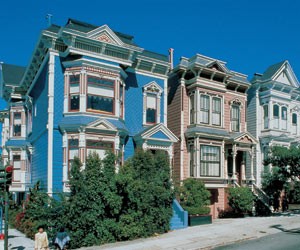From the Hollywood sign to San Francisco’s circa-1873 cable cars—our only mobile national monuments—California’s past and sense of place are unmistakable. Old Sacramento’s wooden-planked streets come alive with the city’s annual Gold Rush Days celebration, while low-slung lanterns illuminate special events along Ching King Road in L.A.’s Chinatown. Pasadena is home to 16 historical districts, the National Trust for Historic Preservation named Santa Barbara one of its "Dozen Distinctive Destinations for 2009," and from movie palaces to castles, the state is chock-full of vintage venues.
Among their many attributes, California’s landmark locales come gilded with atmosphere. Immortalized in Rebel Without A Cause, L.A.’s Griffith Observatory today hosts nighttime star-gazing parties that are open to the public. Stroll Venice Beach’s boardwalk and canals, and director Oliver Stone’s ease in recruiting extras for The Doors becomes obvious. With 160 rooms, 950 doors and stairways leading to nowhere, San Jose’s Winchester Mystery House—reputedly haunted—is a local luminary.
On the Belvedere waterfront in Marin County, the event-friendly Victorian-era China Cabin was once the social saloon of the side-wheel steamer SS China; moored historical ships line San Francisco’s Hyde Street Pier; and Oakland’s USS Potomac, FDR’s presidential yacht, offers history and leisure cruises.
The event-ready mansion and estate circuit includes the Greystone in Beverly Hills, built in 1928; the palatial Filoli Mansion and Gardens in San Mateo County; and South Lake Tahoe’s sprawling Tallac Historic Site.
Poignant encounters are in store at San Juan Capistrano’s event-friendly mission, dating to 1796, and at the restored Angel Island U.S. Immigration Station in San Francisco Bay, the "West Coast’s Ellis Island."
Castles form an evocative part of the landscape, too. In Paso Robles Wine Country, the many-arched, half-moated Eagle Castle Winery is a scenic event destination. Pasadena’s Castle Green, built in 1899, provides eclectic architectural backdrops for shoots and events. And state and national landmark Berkeley City Club, with its barrel-vaulted pool and regal meeting rooms, was designed by Hearst Castle architect Julia Morgan.
Restored to their former glories, California’s event-ready vintage movie palaces can still stage a show. San Jose’s California Theatre, constructed in 1927, is home to Opera San Jose and Symphony Silicon Valley. Other still-whirling Art Deco gems include Modesto’s State Theatre, San Pedro’s Warner Grand Theatre, Redwood City’s Fox Theatre and Oakland’s Paramount Theatre of the Arts. Sonoma is home to the historic Sebastiani Theatre, while the landmark Napa Valley Opera House is an ornate Italianate affair from 1879. Riverside’s Fox Theater was the first to screen Gone with the Wind in 1939, and as the saying goes, "to visit Los Angeles and not see Grauman’s Chinese Theatre is like visiting China and not seeing the Great Wall."
After connecting the young state to America 140 years ago, California’s railroads, vital still to its economy and its tourism, also form an unbroken heritage link. San Bernardino’s History and Railroad Museum, for example, occupies a near-century-old Sante Fe depot. Ventura’s Fillmore Western Railway lazes through lemon and avocado groves, Mendocino’s Skunk Train and Santa Cruz’s Roaring Camp Railroads chug through redwoods, and the Napa Valley Wine Train, well, speaks for itself.







